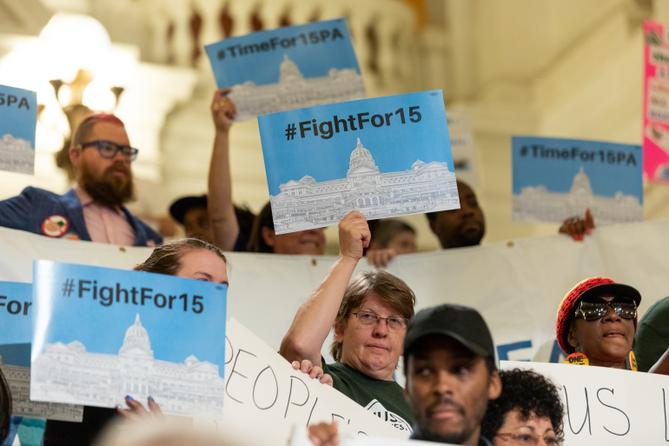Spotlight PA is an independent, non-partisan newsroom powered by The Philadelphia Inquirer in partnership with PennLive/The Patriot-News, TribLIVE/Pittsburgh Tribune-Review, and WITF Public Media. Sign up for our free newsletters.
HARRISBURG — For a seventh straight year, Gov. Tom Wolf is calling for an increase in Pennsylvania’s minimum wage, which has stayed at $7.25 since 2009 — one of the lowest rates and one of the longest stretches without a hike in the country.
Unlike those previous efforts, though, Wolf does so this time against the backdrop of a historic downturn that has decimated Pennsylvania’s buying power, disproportionately impacted low-wage workers, and driven a similar — albeit so far unsuccessful — “Fight for $15” at the federal level.
But while the context has changed, the arguments against a state minimum wage hike largely have not, as demonstrated by a sometimes contentious state House Commerce Committee hearing convened on Wolf’s proposal Thursday in Harrisburg.
Testimony about the proposal — Wolf wants incremental increases from $12 per hour on July 1 to $15 per hour in 2027 — focused primarily on the accuracy of lifting-all-boats forecasts, the timing and consequences for pandemic-battered businesses, and the share of the workforce that stands to be impacted.
Here are five things to know about the debate:
Who’s making minimum wage now?
According to stats provided by the Republican committee chair, state Rep. Brad Roae of Crawford County, there are currently 90,700 minimum wage employees in Pennsylvania, accounting for roughly 1.5% of all jobs in the state, more than half of those in the restaurant industry.
Matthew Knittel, director of the nonpartisan Independent Fiscal Office, testified that a prior analysis found just over half of Pennsylvania’s minimum wage workers are between the ages of 16 and 24, though the Democratic committee chair, state Rep. John Galloway of Bucks County, noted the average age is 35.
Minimum wage workers in Pennsylvania are overwhelmingly women — 77.4% in 2020 — while a disproportionately high share are non-white. Black, Hispanic, and other non-white Pennsylvanians make up 32% of low-wage workers, but just 22% of the state’s population.
What are the potential impacts of a higher minimum in Pennsylvania?
Knittel pointed to a previous study by his office of a proposed $12-an-hour minimum wage increase and said it’s believed it would benefit one million workers directly, grow net wage income for low-wage workers by $2.4 billion, and add roughly $55 million a year to state coffers.
Put another way, income for low-wage workers would increase roughly $34 per week for part-time workers and $55 per week for full-time employees. Hourly tipped employees, many making below federal minimum wage now, would see particularly significant gains.
“Lower wage workers on average spend higher,” Knittel added.
There is also the potential to lose roughly 27,000 new job opportunities, he added, because of a lower rate of turnover. The $12-an-hour minimum wage study also found job hunting may get harder for inexperienced workers, and rural areas with a greater share of small, regional employers may see more negative impacts.
The outlook changes, though, when viewed in the context of this pandemic, simply because of ongoing contractions in the labor market.
“If the minimum wage was raised coming out of the pandemic, we think less people would be helped and less people would be hurt because there are fewer of these jobs currently available,” Knittel added.
An Independent Fiscal Office analysis of the $15-an-hour ceiling in Wolf’s plan is expected later this month or early April.
The gig economy is skewing data slightly.
The movement of younger workers from more traditional industries, like hospitality, to the emerging gig economy is impacting tabulations, Knittel said, accounting for big drops in payroll employees as more take on the label of “independent contractors.”
This matters because independent contractors are not subject to minimum wage protections, minimizing assessments of their overall reach some.
What are the arguments for and against the wage hike in Pennsylvania?
Elizabeth Stelle, a director of policy analysis with the conservative-leaning Commonwealth Foundation, warned that employee benefits and perks could be cut if wages go up.
Stelle also pointed to a drop in the share of Pennsylvania workers earning the minimum wage — though it’s unclear what portion of that owes to the gig economy outmigration Knittel referenced above. Stelle instead urged state lawmakers to focus on providing business owners “regulatory relief” and liability protection, while removing barriers to new career paths for workers through occupational licensing reform.
Testimony in favor of a wage hike was heard from Mikey Knab, director of RAISE High Road Restaurants, a “national network of restaurant owners who are committed to racial and gender justice.”
Knab said there is clear public support for a minimum wage increase, with 1.7 million Pennsylvanians making less than $15 an hour now. (A new Franklin & Marshall College poll shows 67% of registered voters in the state support raising the wage floor to $12, as Wolf has proposed.)
Knab also echoed Democrats who paint the move as not only a moral obligation but also a macroeconomic strategy that raises disposable income and infuses large amounts of capital into the economy via the lower-wage workers who are less likely to save it.
Does Wolf’s proposal have any chance of passing?
It’s unlikely given the current makeup of the state legislature. Republican opposition to minimum wage increases has long focused on what raising overhead might force businesses to do to offset those higher payroll costs. Now, in the middle of a pandemic-related recession and pandemic-related business restrictions, they seem even less likely to reconsider.
It’s also a question of how much and how fast. Wolf’s current proposal starts at $12 an hour, while a $9.50-an-hour proposal passed the Senate in 2019 with only seven Republicans in opposition.
It’s worth noting that Democrats aren’t fully unified on this front either, as the U.S. Senate proved just last week. But that could change.
In Harrisburg this morning, Commerce Committee member Dianne Herrin, a Chester County Democrat, signaled her own change of heart on the subject following the passage of a $1.9 trillion federal COVID-19 relief plan — signed into law by President Joe Biden today — that includes billions in small-business support.
“I initially questioned the timing [of the minimum wage increase] with all the COVID-19 impacts going on,” Herrin said. “But the $1.9 trillion relief bill moved me to the position that the timing is now.”
There will still be interparty rancor, though, as proven by today’s hearing. State Rep. Malcolm Kenyatta (D., Philadelphia) pressed Stelle to reveal her own salary and noted that the Commonwealth Foundation’s CEO earns $290,000 a year, per a tax filing. The line of questioning prompted Rep. Rob Mercuri (R., Allegheny) to stand up and walk off the dais.
100% ESSENTIAL: Spotlight PA relies on funding from foundations and readers like you who are committed to accountability journalism that gets results. Become a member today at spotlightpa.org/donate.

